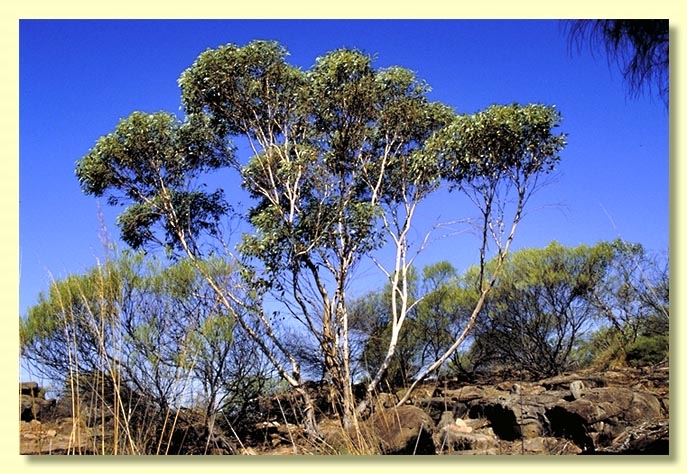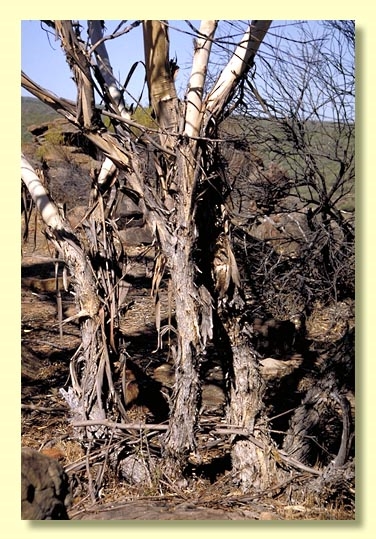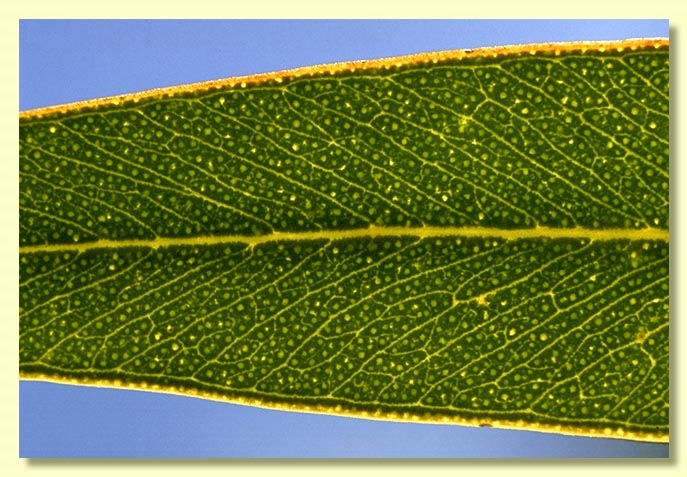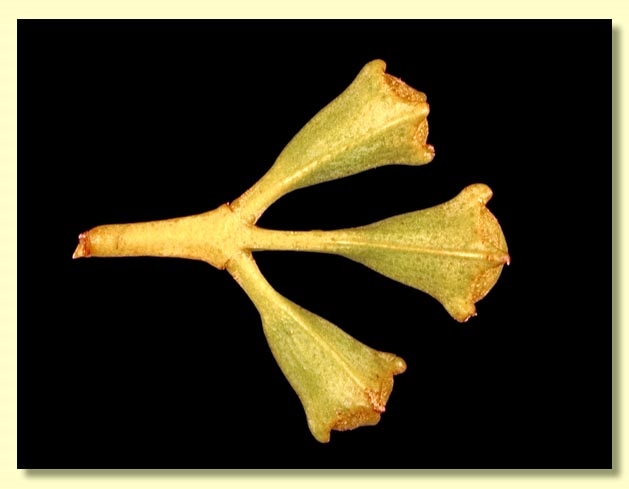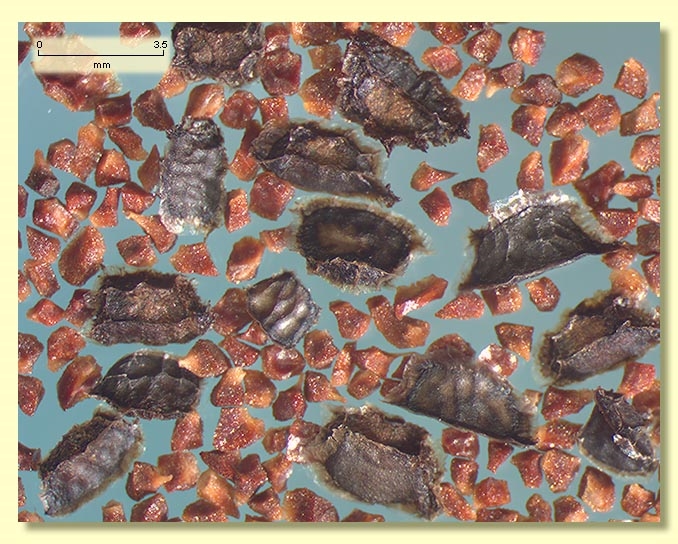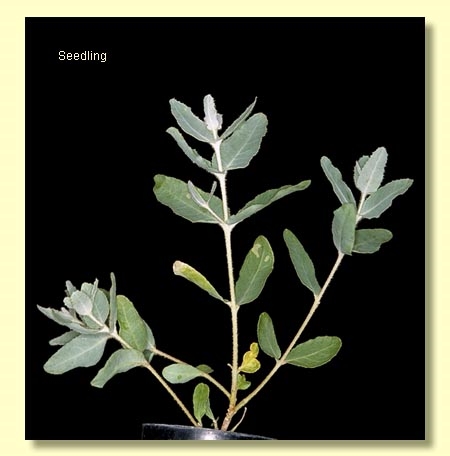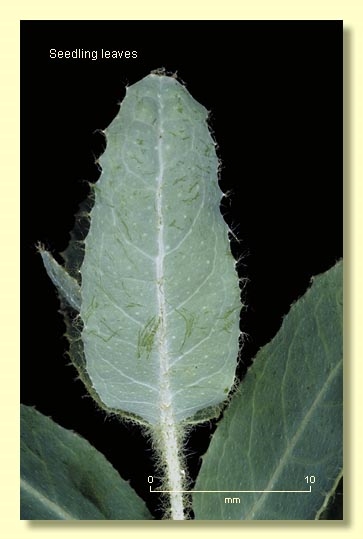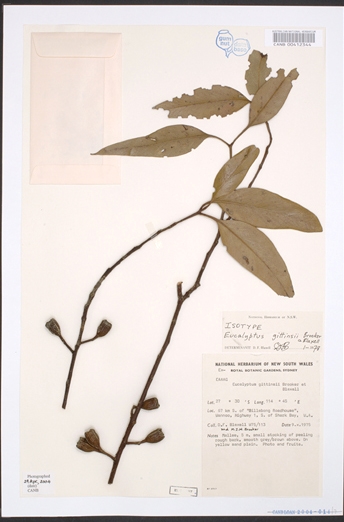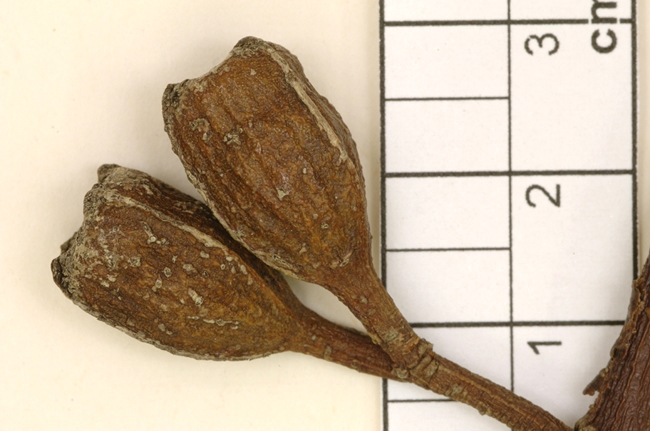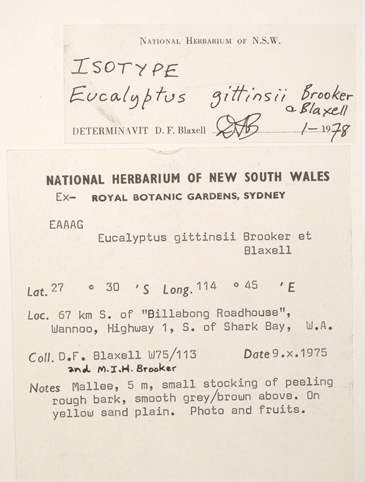Euclid - Online edition
Eucalyptus gittinsii subsp. gittinsii
Eucalyptus | Eudesmia | Limbatae | Heteropterae | Tetraedrae
T: Western Australia: 67 km S of Billabong Roadhouse, Wannoo, Highway 1 (27° 30'S, 114° 45'E), 9 Oct. 1975, D.F.Blaxell W75/113; holo: NSW; iso: CANB, K, PERTH.
Bark usually smooth, grey-brown to white or cream, sometimes with a short stocking of grey-brown flaky rough bark.
Branchlets not glaucous; oil glands present in or absent from the pith.
Juvenile growth (coppice or field seedlings to 50 cm): stems rounded in cross-section, not glaucous, hairy; juvenile leaves opposite and petiolate, broadly lanceolate, 5.5–11 cm long, 3–5 cm wide, base lobed to rounded, apex acute, green, hairy to glabrous.
Adult leaves usually alternate, occasionally opposite to sub-opposite, petioles 1–3 cm long; blade lanceolate to falcate, (6)7.5–13(15) cm long, 1.2–3 cm wide, base tapering to petiole, concolorous, glossy green, side-veins acute, tertiary venation sparse to moderate, intramarginal vein present, oil glands mostly island.
Inflorescence axillary single, peduncles 0.5–1.8 cm long, buds 3 per umbel, pedicels 0.2–0.8 cm long. Mature buds clavate, ca 0.6–0.8 cm long, ca 0.4–0.5 cm wide, hypanthium four-angled, not glaucous, outer perianth whorl sepaline, inner whorl operculate, operculum rounded to flattened, stamens grouped in four clusters, inflexed, anthers oblong to ovoid, versatile, dorsifixed, dehiscing by longitudinal slits (non-confluent), style short, stigma tapered, locules usually 3 or 4, the ovules arranged in 4 distinct vertical rows on the placentae. Flowers whitish.
Fruit pedicellate (pedicels 0.4–1 cm long), cylindrical to barrel-shaped, 1–1.7 cm long, 0.7–1.2 cm wide, not glaucous, usually four angled, disc descending, valves 3 or 4, enclosed or near the rim.
Seeds dull brown to grey to black, obliquely pyramidal with a ragged flange around the edge, sides ribbed, 2–4 mm long, surface smooth not deeply pitted, hilum ventral.
Cultivated seedlings (measured at node 10): cotyledons reniform; stems round to square in cross-section, not glaucous, hairy, leaves sessile to shortly petiolate, opposite, ovate to elliptical, 3–7 cm long, 2–3.5 cm wide, dull grey-green to green, margins irregular due to hairs, apex rounded, base amplexicaul to lobed to rounded, lamina hairy.
Flowering time not recorded.
Eucalyptus gittinsii is a mallee species growing on sandplains from two disjunct areas north of Perth: the first area from the Moore River northwards to Three Springs and the second from the Kalbarri National Park area. The stems are smooth or more rarely with loose, flaky, rough bark. The adult leaves are opposite to sub-opposite, glossy (northern population) to dull (southern population), light green or yellow-green with prominent side-veins and island oil glands.
It is related to E. eudesmioides which differs by the consistently opposite leaves and smaller buds and fruits. It can also be confused with E. conveniens which can be distinguished by having glaucous branchlets and buds.
There are two subspecies:
E. gittinsii subsp. gittinsii
Grows in the Kalbarri National Park area and is distinquished from subsp. illucida by its glossy adult leaves.
E. gittinsii subsp. illucida
Grows from Three Springs south to the Moore River and can be distinguished from subsp. gittinsii by having dull adult leaves.
Eucalyptus gittinsii belongs in Eucalyptus subgenus Eudesmia because of the combination of cotyledons reniform in shape and folded and clasping in embryo, buds with the calyx free and evident as four small teeth around the midline of the bud. (Sections Ebbanoenses and Reticulatae in this subgenus have the calyx fused to the corolla and evident as four small teeth at the apex of the bud.) Within subgenus Eudesmia, E. gittinsii belongs in the section Limbatae, series Heteropterae, subseries Tetraedrae, that is further characterised by having seedling leaves with stellate hairs, the presence of oil glands in the pith of the branchlets, stamens arranged in four bundles, flanged ± pyramidal seeds and buds and fruit square in cross-section. The other species in subseries Tetraedrae are E. eudesmioides, E. pleurocarpa, E. conveniens, E. extrica, E. erythrocorys and E. roycei. Of this group, E. gittinsii is closest to E. conveniens and E. eudesmioides and the differences are discussed above. E. pleurocarpa differs by having glaucous branchlets, buds and fruit ( E. gittinsii is never glaucous). E. extrica is the non-glaucous form of E. pleurocarpa and is distinguished from E. gittinsii by the more consistently opposite, larger adult leaves. E. erythrocorys, with its large red buds and bright yellow anther filaments, should not be confused with any other eucalypt. E. roycei can be easily distinguished by having seven buds in each umbel. (E. giitinsii has three buds per umbel.)

